|
I am writing this page in English with Google translator. Click the Danish version and see the original Danish website.
This English page is suitable for PC - Tablet - Mobile phone. Also see Preface |
A beautiful view from Hovs Haller over LaholmsbugtenNo. 1 What a Swede taught me about junipers, which you pick yourself, if the schnapps is not to taste of turpentine Danish version Next Down The fruit of juniper - Juniperus communis - is actually not a berry but an cones. The first year they are green, the second year they are dark blue. Only the dark blue cones are used, the green ones have a strong turpentine-like taste.
The cones are harvested in September and allowed to air dry for a few days. Gently pound them in a mortar without crushing them and pour them into a bottle. Pour on alcohol so that it covers and let them stand for a week. Check regularly every day to see if it is necessary to add more alcohol as the cones absorb the alcohol. Fill again to cover the cones. When the week is over, the mixture should be sieved, not filtered. Let the essence stand for a month so that it clears and a sediment forms. Gently decant the essence into a beautiful bottle and mix with vodka for a pleasant taste. It's reminiscent of Gin. An oily film forms on the surface of the schnapps in the bottle, so you have to shake the bottle before serving. This is the reason why one should not filter through a coffee filter as the essential oils will settle in the filter. Back to the page where you came from. |
|
No. 2 Purchase of an ADE Pocket Scales TE 1700 weight
Danish version Next Down I was past Kop & Kande in Næstved Center and found this weight for 149.00 DKK. I had to own it. It has a scale of 0.01 grams and a max weight limit of 100 grams. The protective lid, which is seen in the bottom picture, can be used as a weighing container for the herbs. The lid weighs 24.40 grams. The scale uses 2 batteries CR2032 and 15 mA in power. (With or without light?).
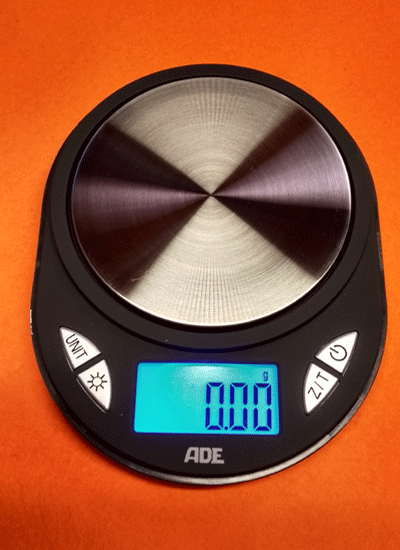
ADE Pocket Scales TE 1700 weight There is of course a TARA function and an on / off button for the built-in light for the display. Built-in "Unit" function for: g = Gram - commonly used for us with herbs ct = Carat - for jewelers gn = Grain - known by fly fisherman, the weight of the fly line oz = Ounce - gold is given in ounces ozt = Troy ounce - see below dwt = Penny weight - see below Some of these units of weight are commonly used in jewelery and dental care in Denmark. It is an international scale, but no manual in Danish. Only German - English - Spanish - French - Italian and Polish. 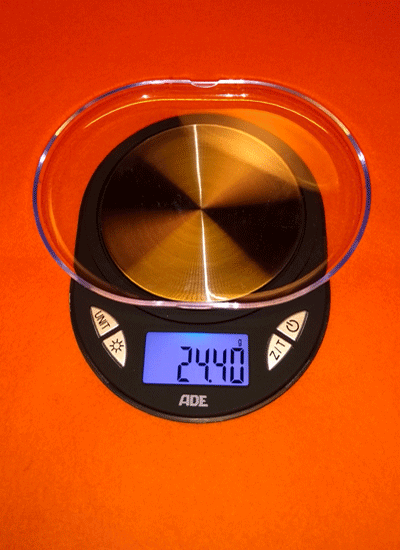
ADE Pocket Scales TE 1700 weight I weighed 10 pcs. cloves to 0.77 grams and 12 pcs. to 1.05 grams. Recommendable. |
No. 3 I will show some bottle types, decoction glasses and essence glasses that I use in the schnapps guild.
Danish version Next Down
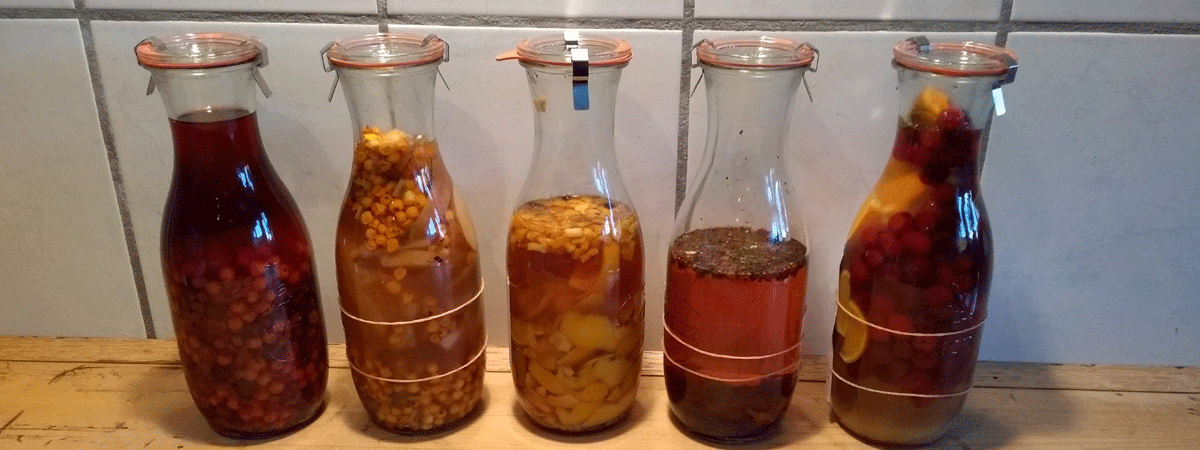
It is these 1 liter glasses with lids that I use for extraction. I have chosen this method: Herbs, fruits and spices mixed in alcohol.
Back to the page where you came from
|
No. 4 Purchase of Swissgold gold filter
Danish version Next Down I have long been dissatisfied with using paper coffee filters to filter spice schnapps for several reasons. Depending on what you filter, the coffee filter is blocking, so you have to change the coffee filter. This causes you to lose a lot of good vodka, as paper absorbs a lot of alcohol.
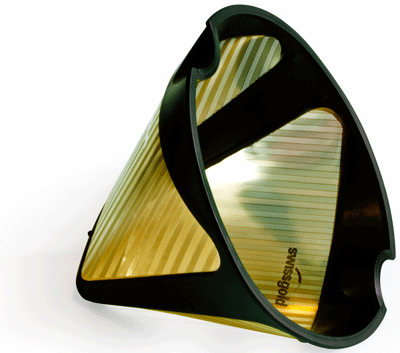
Swissgold gold filter I therefore searched the internet for Filter sieve and several options came up. I focused on Kaffeagenterne and found this Swissgold gold filter for 199.00 kr. I have used it many times for the first filtering and it is really good. I usually only filter once and the second time, I let time do the work. The segments settle over time and then I decant very carefully, so I get a crystal clear schnapps that is worth enjoying. I also think that you get more flavors in your spice schnapps, as Swissgold gold filter does not absorb aesthetic oils. Many of these oils will settle in the paper filter and the more paper filters you use, the more flavors will be lost. Swissgold gold filter can be used several times and simply needs to be cleaned in hot water. Can also be put in the dishwasher if necessary. The fineness of a sieve or wire mesh is measured in "Mesh". It is an American measurement standard that expresses the size of the mesh in a mesh. The number gives indications of which particles will be able to pass through the mesh. The Mesh number is calculated by counting the number of meshes in a mesh per inch or 25.4 mm. A mesh 100 mesh will have 100 mesh openings for every inch (25.4 mm) measured in a straight line, and so on. This means that when the Mesh number is increased, there will be more meshes per inch and thus the mesh opening becomes smaller and smaller particles will be able to get through the sieve / mesh. Mesh number is calculated as follows: Mesh no. = 25.4/(M+T), M = mesh opening and T = wire thickness. This means: Larger mesh Mumber = smaller openings in the mesh. If the two threads you weave with are the same, the Mesh No. in each direction will also be the same. If the two threads have different diameters, the Mesh No. will be different in each direction. You do not use Mesh No. over 400, these are the fine meshes. Here, µ meters are used as a measure of the opening of the sieve/net. I have ordered one and will make a comment when it has been tested. The sieve works well, but it cannot handle the finest "floating particles". Here I have to use time - sediment traps and then the decantation method with my Decantation apparatus with electric air pump. Then I have bought another one, but in a different version. More to come later. |
|
No. 5 Purchase of Philips juicers
Danish version Next Down I have long called for a press or centrifuge to get the last juice and vodka out of the pulp on the spice schnapps. Therefore, I searched the web what options there were. All new "juices" cost a fortune. Used on various sites was between DKK 200.00 and DKK 400.00. It was an option. But when I visited the home thrift store, I found a Philips juicer marked with DKK 150.00. That was the case. I came to the checkout and they told me, "Today it's half price". How lucky can you be.
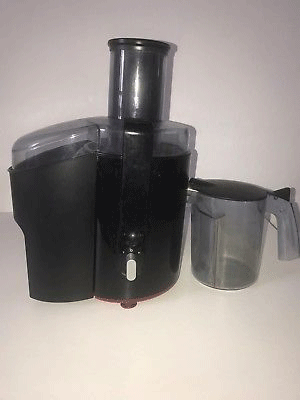
Philips juicers The juicer is cleaned and tested on fruit, works impeccably. However, I need to try it out on spice schnapps as they are still standing and drawing. I will return with results in early 2018. Here is the result: It seems impeccable, BUT what a cleaning after each spin. I do not want to do that. For large scale operation it's OK but I got a new idea, see here my Press Pistol. |
|
No. 6 Decanting device with electric air pump
Danish version Next Down I have made a "Skafot" where the bottles can stand when the schnapps needs to be decanted. This can be done without the sediment coming along. The cabinet frame is made of 10 mm X-plywood and glued together with white joiner's glue. Madsen has made the scaffolding according to a drawing from Walter. Drawing with measurements and the finished product can be seen in the pictures below.
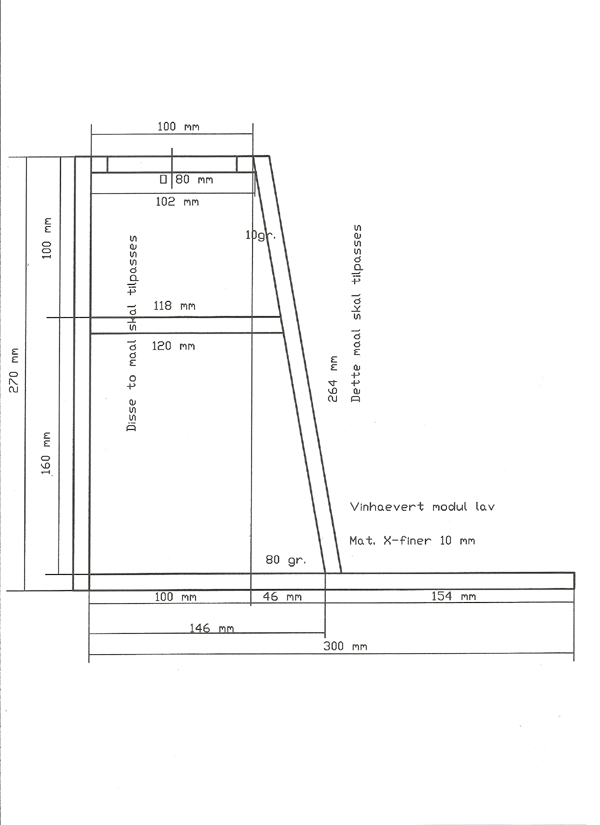
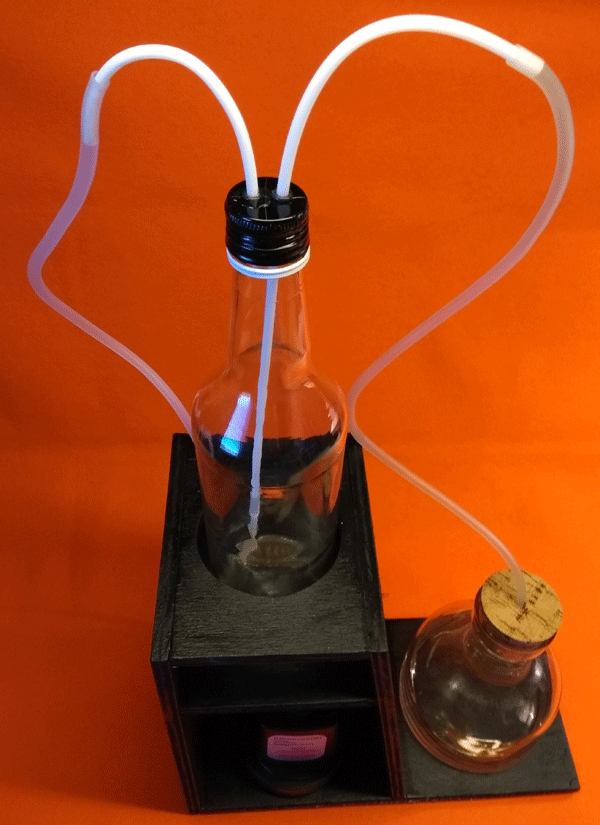
Drawing for and the finished product: Decanter with electric air pump The electric air pump is from Harald Nyborg with order no. 6268 and costs 89, 00 kr. The hoses are made of silicone with dimensions Ø 4/6 mm 5 meters item no. 038528 and cost DKK 104.00 online at Frederiksen. The white plastic pipes are bought from birthday flags in different places (Rema 1000 - Brugsen), But make sure that the pipe is 4.2 mm thick on the outside to fit the hose. I have seen pipes of 3.9 mm and 5.3 mm (paper flag 10 pcs. DKK 10.00) and 6.5 mm (plastic flag 10 pcs. DKK 20.00) When the plastic pipe is to be bent, an insulated copper wire (installation wire) is inserted and the plastic pipe is immersed in boiling water. Carefully bend the tube with your hands - wear gloves - and when the bow is correct, hold it in place while immersing it in cold water. Two 4.2 mm holes are drilled in the capsule that fits the bottle (drill Ø 4.2 mm from XL-Build). The bottle shown is vodka from Netto. The capsule is from Rynkeby's Ginger Shot, as it has a silicone gasket inside. The plastic pipe for the air pump is sealed with two component epoxy (red type). The plastic tube for the receiver bottle is sealed with a 4 mm O-ring on the top and bottom. Once the long plastic tube is inserted through the capsule, heat the end gently with a fan heater and squeeze the end together with a pair of pliers so that the sides are welded together. Practice first because the plastic pipe melts quickly if the heat gets too high. The welded bottom is adjusted with a scissors, and approx. 1 cm from the bottom, cut a v half through the plastic tube so that there is a hole of 2 to 3 mm, use a scalpel. Mount the electric air pump on the bottom, as shown, with 5 cm wide Velcrobånd (Velcro straps). The pump's thin spigots are cut to fit the 4.2 mm plastic pipe. Plugs and plastic pipes are held together and sealed with shrink flex from Biltema. Finally, test the decanter, fill the bottle with water, screw on the lid, insert the hose into the receiver bottle (I use a 3/4 liter carafe), turn on the pump. The pump will now create overpressure in the bottle and the water will start to flow. As soon as the water flows into the receiver bottle, the pump can be switched off. An alternative would be to turn the pump connections over and suck the receiver bottle empty of air, but then this bottle must be made completely airtight with a rubber stopper. There must then be two holes in the stopper, and this must also be in the bottle with schnapps, because otherwise negative pressure will form in the bottle as the schnapps runs out. |
|
No. 7 The 4 Vodkas that I use are either from Netto, Rema 1000, Aldi or Lidl, latest new
after moving to Jutland, I use Swedish Vodka in 3 l Big Bag from Fleggaard DKK 220 Danish version Next Down Netto:
OLIOFSKA 37.5Vol.% 700 ml is a vodka that has been distilled 4 times. Imported from Fauconnier in France, which among other things makes Polish Vodka. What the vodka is made of is not known, but probably grain. The price is DKK 57.95. Taste assessment points: 6.33.
Rema 1000: POLSKEY VODKA 37.5Vol.% 700 ml is a vodka distilled twice. Manufactured by Polini Group Italia SRL. The vodka is made from wheat. The price is DKK 57.95. Taste assessment points: 6.33. Aldi: ZARANOFF 37.5Vol.% 700 ml is a vodka distilled 3 times. Manufactured by Rola Likörfabrik, Rottenburg in Germany. The vodka is made from sugar beets. The price is DKK 57.95. Taste assessment points: 5.66. Lidl: RACHMANINOFF 37.5Vol.% 700 ml is a vodka that has been distilled 3 times. Made in Germany. The price is DKK 57.95. Taste assessment points: 6.00. 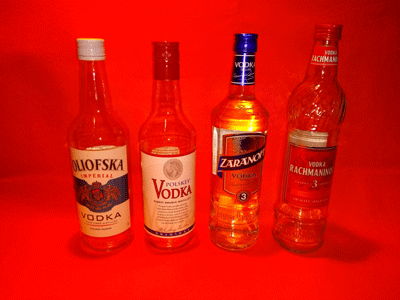
The 4 Vodkas I use are either from Netto, Rema 1000, Aldi or Lidl Today, Sunday 14 January 2018, I have tastings of the 4 Vodkas I use. The price is the same, so I will try which vodka to use. Basically, a vodka is best when distilled several times. Therefore, OLIOFSKA should be the best. ZARANOFF and RACHMANINOFF in a shared second place and POLSKEY VODKA in a third place. Another factor that also comes into play is the ingredients on which the vodka is made. I'll see. Result: OLIOFSKA and POLSKEY VODKA shared 1st place, RACHMANINOFF 2nd place and ZARANOFF 3rd place. 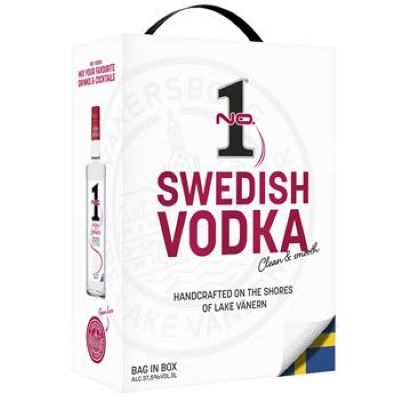
Swedish Vodka 3 l in Big Bag from Fleggaard for DKK 220 Classic Swedish vodka No.1 Premium Vodka at 37.5% Vol. is a Swedish vodka, made on the Swedish west coast. It has a clean aroma and taste with hints of lemon and sweet almond. The vodka is distilled 3 times to remove all impurities and has a delicious, smooth and fresh character. The product is made from Swedish-grown wheat using water from Lake Vänern, a historic glacial lake that is famous for its purity. Here is a description of how Vodka should taste. An excellent vodka is traditionally defined by several key factors that combine to create a high-quality spirit. The classic definition focuses on the following elements: 1. Purity Distillation: An excellent vodka goes through several rounds of distillation, which removes impurities and unwanted flavors. The more times a vodka is distilled, the purer and more refined it becomes. Filtration: After distillation, the vodka is often filtered through materials such as activated carbon, which further helps remove impurities and provides a smoother taste. 2. Neutral taste Taste neutrality: According to the classic definition, an excellent vodka should have a neutral taste, without distinct flavor notes from the raw materials it is made from, such as grain, potatoes or grapes. The taste should be as clean and mild as possible. Mouthfeel: Although the taste is neutral, the vodka should have a soft, pleasant mouthfeel without any harsh or sharp aftertaste. 3. Smoothness Smoothness: An excellent vodka that glides down easily and has a soft and round texture. There should be no burning sensation in the throat, which indicates high quality. Aftertaste: The vodka should have a clean and short aftertaste without bitterness or unpleasant notes. 4. Quality of raw materials Raw materials: The quality of the raw materials used in the production of vodka is crucial. The best vodkas use high-quality grains, potatoes or other starches grown under optimal conditions. Water quality: The water used in production is as important as the raw materials. The best vodkas use spring water or other high-quality pure water, which adds to the purity. 5. Absence of additives No Additives**: A classic vodka should not contain any artificial flavors, sweeteners or colorings. It should be as natural as possible, highlighting its purity and quality. 6. Tradition and craftsmanship Manufacturing process: Many of the best vodkas are produced using traditional methods that have often been perfected over generations. The craftsmanship behind the production is an important part of what makes a vodka excellent. Geographical Origin: Some of the most recognized vodkas come from specific regions where tradition and experience play a major role in production, such as Russia or Poland. Combined, these factors produce a vodka that is clean, smooth, and easy to drink, and which meets the classic definition of excellent quality. I have tasted Swedish Vodka and must admit that it meets most of the requirements above, so it is the one I will use in the future. See the list with Vodka Brand. |
|
No. 8 My homemade "Press Pistol" according to the principle "Grouting tools"
Danish version Next Down Now I was tired of washing the juicer every time I made a spice schnapps. Therefore, I got the idea to make a small "Press Pistol" for approx. 300 ml herbs / fruits / berries, which were easy to clean after each pressure. So when I saw my silicone Caulking gun in the workshop, I got the idea.
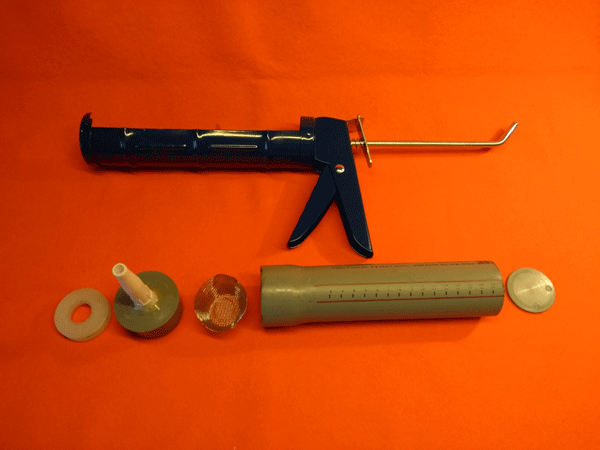
Parts for my Press Gun In Biltema I bought: Caulking gun item no. 192796 to DKK 19.90, 10 pcs. nozzles item no. 364835 to DKK 12.90 and a the siev item no. 850069 to DKK 17.90 In Jem & Fix I bought: PP drain pipe in gray Ø 50 mm x 25 cm for DKK 15.95, PP plug Ø 50 mm for DKK 6.95 and PP plug Ø 40 mm for DKK 6.95 The spacer was made from an old 6 mm nylon cutting board. 2 rings were drilled out with a cup drill and glued together. Start by cutting pipes Ø 50 mm off in the side where the rubber gasket is located on the left. From here, measure the length of the pipe to 20.4 cm and cut off. Use a cutting box because it is difficult to cut straight into pipes. In a plug Ø 50 mm, drill a hole that fits the nozzle, here 17 mm. The flap on the mouthpiece is cut off and glued together with the stopper with a 2-component glue. Red araldite. The siev is cut clean at a height that fits into the stopper. The small plug Ø 40 mm is sawn free of the pipe so that it can be used as a pressure pistol for the Caulking gun. The nylon ring is adapted to the Caulking gun diameter and the hole to the nozzle. 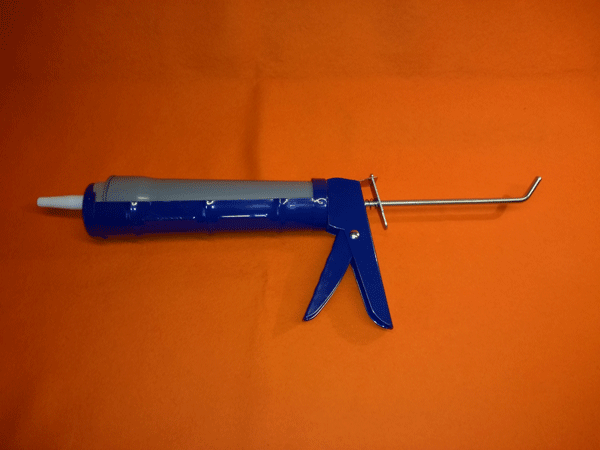
The finished Press Gun I have tried my Press Pistol and have come to this result: 70 g of herbs - a mixture of roots, stems, leaves and fruit drawed on a 70 cl bottle of vodka. Was sieved and the rest filled in the press. 7 cl of vodka came out, that is 10%. I got a total of 66.5 cl of spice schnapps. Loss of 3.5 cl or 5%. Without the Press Pistol, the shrinkage would be 10.5 cl or 15%. PP container weighs 98 g (without Caulking gun) and is easy to clean. It can only be recommended to make your own "Press Pistol" when the shrinkage can be reduced by 1/3. |
|
No. 9 Each refractometer has its own special area of application
Danish version Next Down A refractometer is an optical measuring device used to measure the refractive index of various liquids. There are different types of refractometers, some of which are stationary and others are handheld. Some mechanical and others digital. However, they all work based on the same principle of the refractive index of light. See my Excel spreadsheet Fermentation for other values of °Brix. Open the EXCEL spreadsheet in a new window and see Sheet "Most Schema".
When wave phenomena move between areas with different propagation speeds for the waves in question, the direction of movement of the waves is changed by the phenomenon called refraction. Refractometer salinity from 0 to 100‰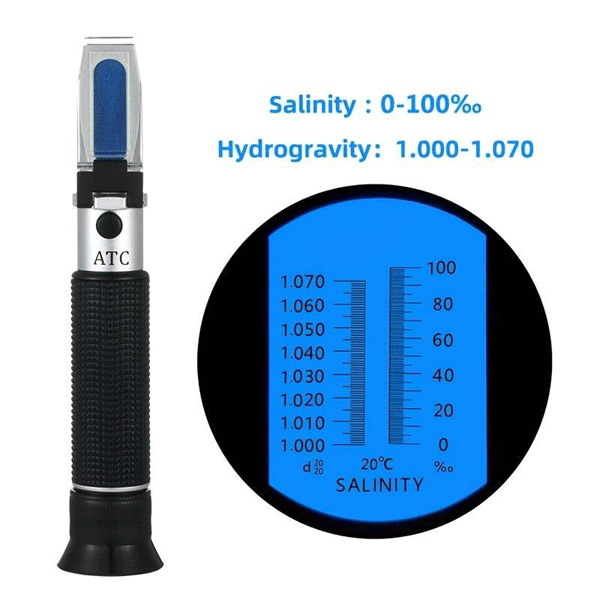
Refractometer salinity from 0 to 100‰ With this refractometer, the salt content of seawater is measured. It is calibrated from 0 to 10% salt. The refractiometer has ATC - Automatic Temperature Compensation - from 10°C to 30°C. Calibration (zero setting) with deionized water takes place at 20°C. Which is normal for (all) Refractiometers. Refractometer specially designed for automobiles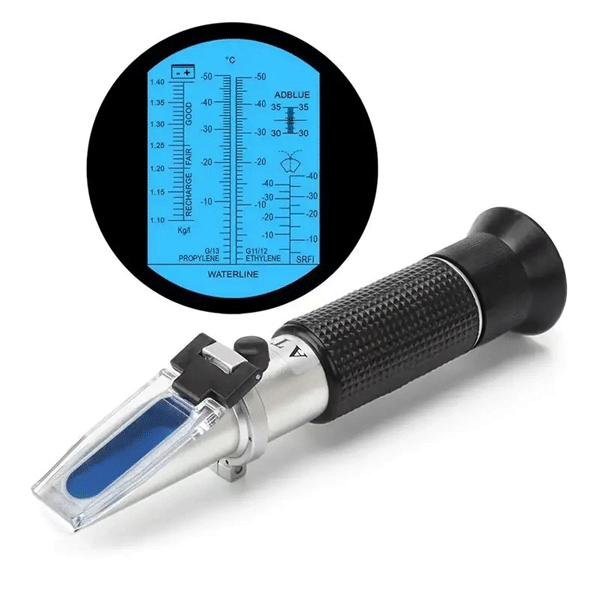
Refractometer specially designed for automobiles With this refractometer specially designed for automobiles, the freezing point of antifreeze is measured and several other things that I am not aware of. The refractiometer has ATC - Automatic Temperature Compensation - from 10°C to 30°C. Calibration (zero setting) with deionized water takes place at 20°C. Which is normal for (all) Refractiometers. Refractometer for determining alcohol in water, measurement range 0~80%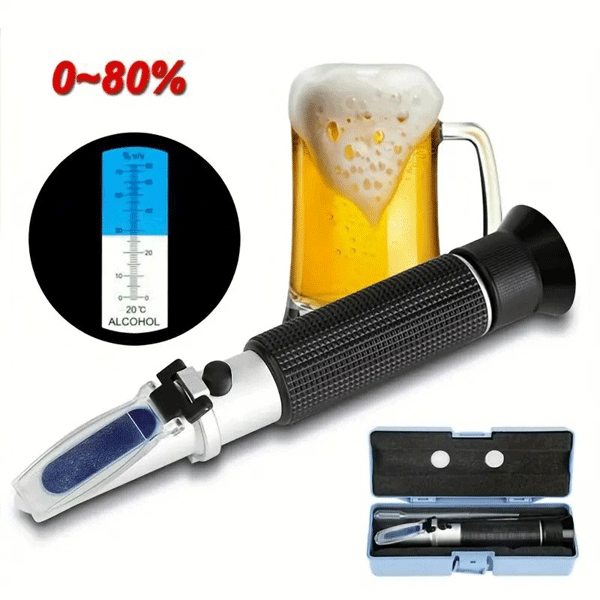
Refractometer for determining alcohol in water, measurement range 0~80% This refractometer is designed for measuring distilled beverages (ethanol with water) such as spirits. Ideal for professional and non-professional winemakers. The refractiometer has ATC - Automatic Temperature Compensation - from 10°C to 30°C. Calibration (zero setting) with deionized water takes place at 20°C. Which is normal for (all) Refractiometers. The measurement range is from 0 to 80 Vol.% alcohol. The accuracy is 1% from 0 to 60% and 2% from 60% to 80%. Refractometer for Brix measurement from 0 to 32%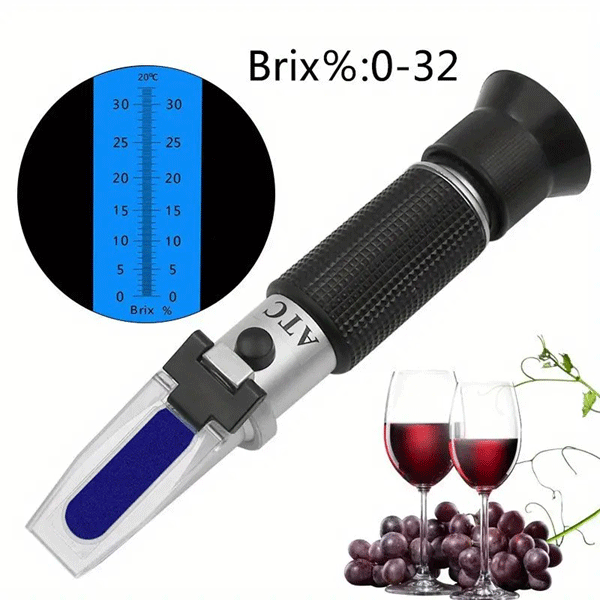
Refractometer for Brix measurement from 0 to 32% With this refractometer, the Brix % in a glucose/sugar mixture is measured from 0 to 32%. The refractiometer has ATC - Automatic Temperature Compensation - from 10°C to 30°C. Calibration (zero setting) with deionized water takes place at 20°C. Which is normal for (all) Refractiometers. Brix is a unit of measurement for the specific gravity of a liquid. Brix degrees can be measured with a hydrometer whose scale is calibrated to sugar solutions of known concentrations. Pure water shows 0 degrees brix, a 10% sugar solution shows 10 degrees brix. These degrees can also be determined via the refractive index of the solution. Another measure of a liquid's specific gravity is the Baumé. The relationship between Baumé and Brix can be found in tables, e.g. is 20°Brix = 11.1°Baumé. There are several variants of these refractometers, mainly with varied scale and several scales. A suitable refractometer for the amateur wine/beer brewer would be the lower refractometer with two scales. One for the Brix measurement and two for the reading of the alcohol percentage in fully fermented fruit must, eg. is 20°Brix = 11.1°Baumé = 83°Öchsle = 14.8 vol.% theoretical alcohol or 13.1 vol.% potential alcohol. You just have to remember that you cannot measure the percentage of alcohol in a distillation. The refractiometer measures the specific gravity of a fruit must in Brix and converts it to an alcohol percentage when the fruit must is fully fermented. Refractometer for measuring water in honey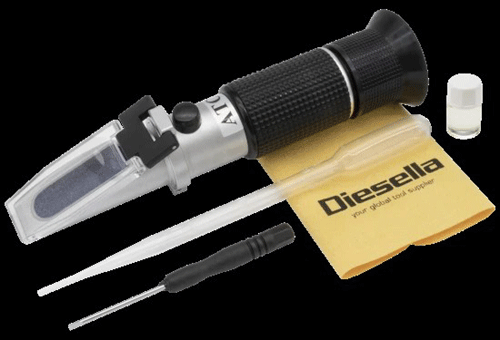
Refractometer for measuring water in honey With this refractometer, water in honey is measured. The refractiometer has ATC - Automatic Temperature Compensation - from 10°C to 30°C. Calibration (zero setting) with deionized water takes place at 20°C. Which is normal for (all) Refractiometers. The refractometer is designed to work with sugar-related liquids with high sugar content, honey, jellies, jams and syrups to help monitor and control sugar concentrations in foods and beverages. Main areas of application: beekeeping, honey production, checking the ripeness of fruits, verifying the product quality after harvest and/or checking concentrations during processing. Refractometer for measuring Brix, °Öchsle or °Baume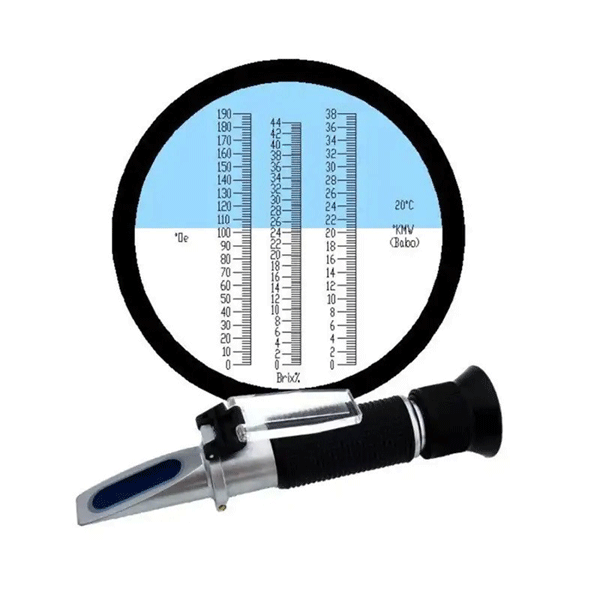
Refractometer for measuring Brix, °Öchsle or °Baume With this °Öchsle-Brix refractometer, you can measure all sugary liquids such as fruit juice, soft drinks, honey. It can also be used to check the sugar concentration in food and drink, but in alcoholic drinks the measurement will not be correct, as alcohol has a different refractive index than water. The refractiometer has ATC - Automatic Temperature Compensation - from 10°C to 30°C. Calibration (zero setting) with deionized water takes place at 20°C. Which is normal for (all) Refractiometers. The measurement ranges for Brix = sugar mass are from 0 to 32%, Öchsle from 0 to 140° and °Baume from 0 to 25°. A widely used instrument for winemakers to measure °Öchsle. The measuring unit indicates the sugar content of grape must. A °Öchsle of 80° means that 1 liter of must weighs 80 grams more than 1 liter of water. Number of °Öchsle divided by 8 gives an approx. measure of the alcohol percentage of the upcoming wine. So here we get 80 : 8 = 10 vol.% alcohol in this must by full fermentation of the sugar. |
|
No. 10 Oak for Beer Wine Spirits
Danish version Next Down Oak is an exciting "spice" to play with in some spice schnapps, if you know how to dose correctly. Too little has no effect and too much gives the sensation of chewing on a stick.
In addition, not all spice schnapps are suitable for enjoying the effect. I have special experience with ripe, dry hazelnuts, walnuts and acorns. (Not with green walnuts). 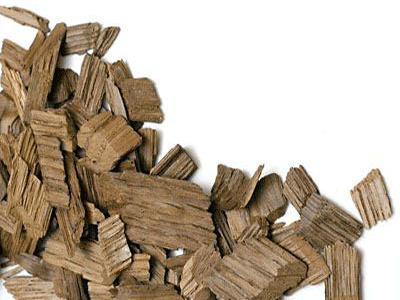
Oak for Beer Wine Spirits: Wooden chips Oak can be bought in sticks and in chips, all are roasted and available as lightly roasted, medium roasted and highly roasted. French oak can be bought as smoked oak and American oak can be bought made from old Bourbon Whiskey barrels. All of which you can play with in your beer, wine or spice schnapps. When you add oak to your beer/wine, you must be sure that the oak is disinfected so that you do not get wild yeast in your brew. Boil it for 5 minutes before adding it to the beer/wine. Or put the oak in a glass with a lid and pour 40% alcohol and leave it for at least 1 week. Use the following Whisky, Cognac, Rum or Vodka. Vodka is the cheapest, but does not add flavor to the beer/wine. 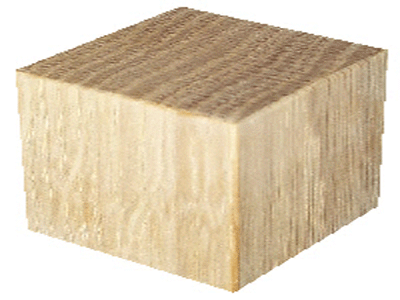
Oak for Beer Wine Spirits: Wooden sticks Then comes the dosage: How much and for how long. Like everything else, you can always add more, but you can't take it out again. Likewise, tastes and preferences are different. It's just about experimenting to find your own taste. But you should get a clue for Spice schnapps: 1.5g to 2g for 700ml of Vodka and brew time for a week, then you have to taste whether it needs another week. A good idea would be to put 1g oak chips in 250ml of vodka and let it brew for 4 weeks and taste it every week. Make your notes and you're ready to dose your spice schnapps. Remember that you can always dilute this sample with more Vodka. P.S. This must be done for each type of oak. Finally, use ONLY food-approved oak for beer, wine and spice schnapps. NB: Smoked oak is available in light, medium and strong smoked. Can be bought where you buy accessories for beer brewing. I used a heavy smoked oak. You can buy oak chips, french heavy roasted here or here. American oak chips can be bought here. If you can no longer get oak with a smoke flavor, you must smoke it yourself. There's a new webshop in my neighborhood, maybe they also sell smoked oak: Kongsted Hjemmebryg. |
|
No. 11 How to sweeten your spice schnapps with honey
Danish version Next Down Honey is many "things", but the honey I use is a special heather honey from the foot of the Pyrenees. Now why that! Yes! I came across the honey by chance and found that the taste of the reddish-brown soft heather honey was suitable for sweetening a spice schnapps. It was actually when I made "Cough syrup". But like all honey species, this Callunaheide honey give flavor, color and cloudiness to the spice schnapps.
Flavor and color are essential to the selection of this Callunaheide honey, so I had to do some experimenting to get a crystal clear spice schnapps. I have now succeeded and therefore I would like to share my experiments, which can be imitated with all other heather honey species. I make many essences and when I wanted to make an essence on heather flowers, I had the idea to sweeten it with Callunaheide honey. In my bottle of filtered heather flower essence I added 20 ml of honey. The essence became totally cloudy and so I put it away for a few days to see what would happen. Was stored at room temperature. 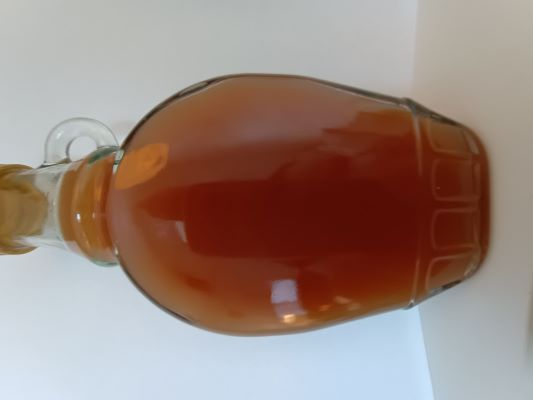
250 ml heather flower essence with 20 ml heather honey Just made and shaken well - a very cloudy essence Above is the image of the Callunaheide honey essence. I first made a crystal clear heather flower essence in 300 ml Vodka 37.5Vol.% The Swedish and 16 grams of heather flowers. I cut a hat full of the best top shoots with purple flowers, ripped them and got 16 grams of pure purple flowers. Fits the 250ml bottle as the rest was lost in the flowers and filter. 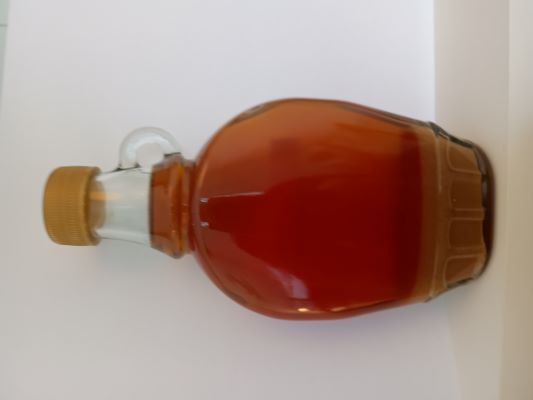
Then look here after 2 days. Good with sediment Premium quality bee honey is Calluna heather honey. The honey is unmixed and unfiltered, matured in the gingerbread and comes from selected traditional regions. It is stored and bottled in a way that protects the active ingredients, such as antioxidants and the enzymes, because the natural colony temperature is not exceeded approx. 38°C. I'll come up with something more when I need to sweeten some "Spice Schnapps". Note: In the past I used Danish heather honey from the heath in West Jutland, but bought in Zealand. You shouldn't because they add other honey and then the honey crystallizes over time. A completely pure heather honey from bell heather will largely not crystallize. You can tell a real "Heather honey" by the color, the softness and the strong aroma - and then by the price, 500 grams approx. DKK 130.00. |
|
No. 12 Measurement of acidity pH value in a fruit solution
Danish version Next Down In our hobby for the production of Spicy Schnapps we use Alcohol also called Ethanol with formula C2H5OH can also be written CH3CH2OH. Pure alcohol has a pH value of 7.33 and this means that alcohol is slightly alkaline. When we then pour alcohol on fruit, it will extract sugar, acid and other flavors from the fruit. If the fruit is very sour, it will result in our fruit schnapps also being sour. It is this value that I want to measure, so that I have an idea of the degree of acidity and the sugar content of the future Kryddersnapse.

The pH scale from 0 - 14 with symbols of pH value from daily lif The picture above shows that orange juice has a pH of 3.7 and up to pH 5 we find banana. I would just like to mention that lemon and other citrus fruits are at approx. 2 pH. Search the web yourself if you need more values. Acid comes in many different forms, of which tannic acid is one of them, but acid and tannic acid are two different forms and are often confused. Tannic acid is called tannin and is first felt on the gums, gums and teeth as a dryness in the mouth = Astringent. The tannic acid comes from the skin, seeds and stems of the fruit. Therefore, one should limit these things when the extract is made. The amount of tannic acid also depends on the length of the "Extraction time" and storage in "Oak casks". If someone does this. 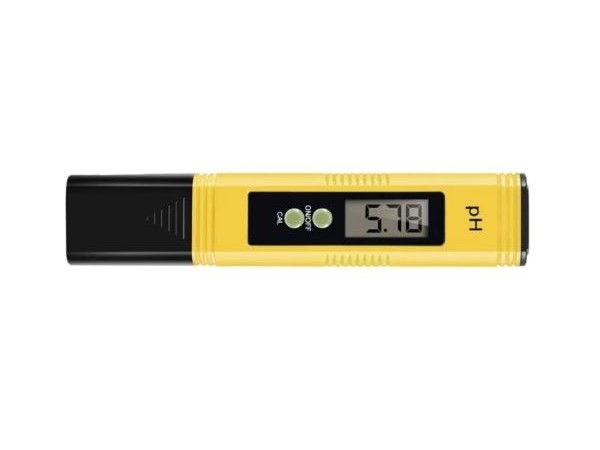
pH Digital meter from 0 - 14 pH value Above you can see the pH Digital meter that I bought on sale for DKK 49.00 + shipping. I received one bag with calibration powder, which must be dissolved in 250 ml of demineralized water. I received the package just before Christmas 2024 and now I am getting to know the instrument. Start with the calibration powder, mix it with 250 ml of demineralized water at room temperature in an absolutely clean glass. I used a new 500 ml boiling glass, because there are many times of use. The calibration powder gives a pH of 6.86 at 25°C. Prepare the probe, remove the film over the display. Follow the 4 pictures below. Turn on the probe with the top button. The calibration button is the bottom below. Easy to calibrate: Press CAL for 5 seconds to enter calibration mode, and release. The display starts flashing 6.86 - Wait until the display stops flashing to complete the calibration. The display now shows 6.86 even though the temperature is only 20°C. The pH meter has a function ATC, which means "Automatic Temperature Control" - however within the range 0°C to 60°C. Note: I only received one bag of calibration powder for pH 6.86; the other two values available, 4.01 and 9.18, I have for the same pH meter, but from another supplier at a higher price. 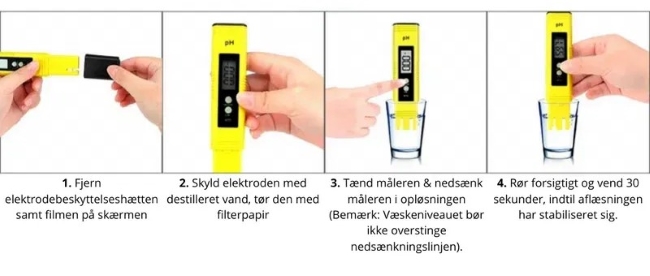
Manual: pH Digital meter from 0 - 14 pH value Step 1: Remove the protective cap Step 2: First rinse the electrode with distilled / demineralized water and dry it with filter paper Step 3: Turn on the meter by pressing the ON/OFF key Step 4: Immerse the pH meter electrode in the solution to be tested - ONLY to the slot Step 5: Stir gently and wait about 30 seconds until the reading has stabilized Step 6: When finished, clean the electrode with clean water, turn off the meter by pressing the ON/OFF key Step 7: Always replace the protective cap after use What is included a pH meter of? Electronics, which can process the voltage difference between a glass electrode and a reference electrode and calculate the pH value. Type Electronics, and read much more about a pH measuring device. How to measure the pH of your fruits and berries: If you have a liquid fruit or berry juice without solid ingredients (e.g. apple juice), you can place a suitable sample amount in a beaker and directly measure the pH value. If you want to measure on a fruit - (e.g. apples that you have in the garden) - you must do the following: Weigh 5 g of the apple, put it in the blender, weigh 20 g of distilled / demineralized water and put it in the blender. Now blend the sample. Now let the sample stand for approx. 15 minutes, stir the sample well, let it rest for another 15 minutes and now measure the pH value. If with your tools you think 5 g and 20 g are too little, use the whole apple, but weigh it first. Weigh 4 times the weight of the apple in distilled / demineralized water and use this sample. 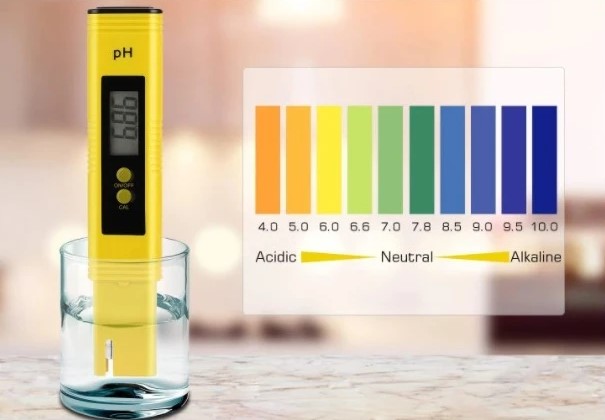
Place the pH meter in the solution and read the pH level on the display after 30 seconds The immersion line is where the slit ends There are also strips that are placed in the solution and the color is read Tannic acid should preferably be avoided in your Kryddersnaps, but you should have the other "good acids" in your Kryddersnaps, otherwise it will become "Sour". With too much acid it will become "Sharp", so you have to find a "Balance". That is what I will measure myself against when I taste Kryddersnaps at the same time. I know two "good acids" from the time I made red wine and white wine, namely tartaric acid and malic acid. Tartaric acid was used for "flat" berries, e.g. elderberries for red wine and malic acid in the form of adding apples to elderflower, without these apples the Elderflower Schnapps will become sour or flat, as some might say. It was a Dane named S.P.L. Sørensen who developed the pH scale. He was employed at the Carlsberg Laboratory and in connection with developing beer, he needed a "Measurement Scale" so that he could always return to the process and make the good beer again. This scale became the pH scale. He found that the enzymes for beer production work optimally at a pH between 5.4 and 5.6. The scale is logarithmic, so this means that a cola with a pH of 2.5 is 10 times as acidic as an orange with a pH of 3.5 - and - 100 times as acidic as a tomato with a pH of 4.5 - and - 1000 times as acidic as a cabbage with a pH of 5.5 - and - 10,000 times as acidic as an avocado with a pH of 6.5. Distilled water pH 7. Note: Continuation to follow. |

one.com |